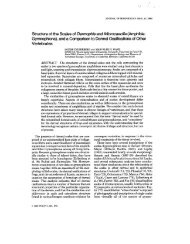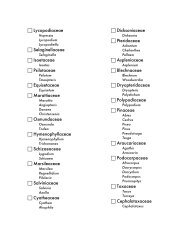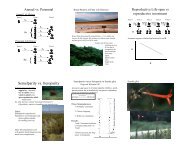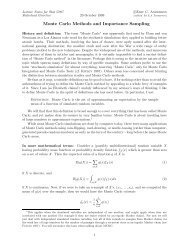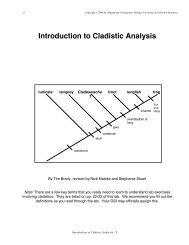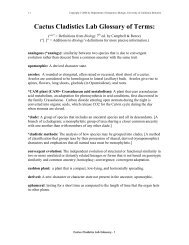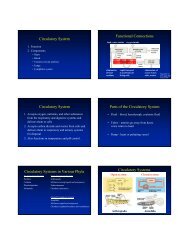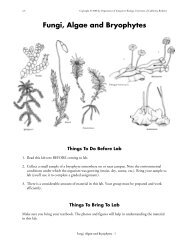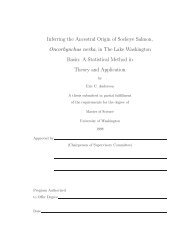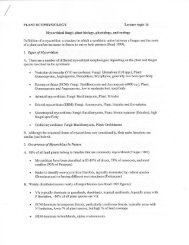Using ecological niche modeling for quantitative biogeographic ...
Using ecological niche modeling for quantitative biogeographic ...
Using ecological niche modeling for quantitative biogeographic ...
You also want an ePaper? Increase the reach of your titles
YUMPU automatically turns print PDFs into web optimized ePapers that Google loves.
608 KAITLIN C. MAGUIRE AND ALYCIA L. STIGALL<br />
that allows analysis of <strong>biogeographic</strong> patterns<br />
within a hypothesis-testing framework. Detailed<br />
range models provide a robust framework<br />
to interpret changes in geographic<br />
range size and distributional patterns across<br />
a significant climatic change and can potentially<br />
allow additional analyses of fine-scale<br />
patterns of <strong>ecological</strong> resource utilization.<br />
This study, combined with the successful<br />
results of Stigall Rode and Lieberman (2005)<br />
using ENM to model marine invertebrate<br />
taxa, suggests that ENM, and specifically the<br />
GARP method, offers great potential to<br />
investigate the relationship between abiotic<br />
and biotic controls on species distribution in<br />
the fossil record across many clades and<br />
geologic intervals.<br />
Acknowledgments<br />
We thank D. I. Hembree, K. A. Milam, and<br />
P. M. O’Connor <strong>for</strong> reviewing initial drafts.<br />
We would also like to thank G. J. Retallack, P.<br />
J. Markwick, B. H. Passey, and J. D. Damuth<br />
<strong>for</strong> providing data, and C. M. Janis and Y.<br />
Wang <strong>for</strong> help with finding additional data.<br />
Thanks to J. Alroy and R. C. Hulbert <strong>for</strong><br />
clarification with the phylogenetic relationships<br />
in the clade and R. Purdy <strong>for</strong> assistance<br />
with access to the collections at the National<br />
Museum of Natural History. C. Dobel assisted<br />
with data collection and database development.<br />
This project was funded by Ohio<br />
University Geological Sciences Alumni Student<br />
Grant, Geological Society of America<br />
Grants-in-Aid Award, and Ohio Center <strong>for</strong><br />
Ecology and Evolutionary Studies Fellowship<br />
(all to Maguire), and an ACS Petroleum<br />
Research Fund Starter Grant and Ohio University<br />
Baker Fund Award to Stigall.<br />
Literature Cited<br />
Alroy, J. 2002. Synonymies and reidentifications of North<br />
American fossil mammals. The Paleobiology Database http://<br />
paleodb.org/<br />
——— . 2003. A <strong>quantitative</strong> North American mammalian<br />
timescale. www.nceas.ucsb.edu/,alroy/TimeScale.html<br />
———. 2007. Synonymies and reidentifications of North American<br />
fossil vertebrates and so <strong>for</strong>th. The Paleobiology Database,<br />
http://paleodb.org/<br />
Anderson, R. P., A. T. Peterson, and M. Gómez-Laverde. 2002.<br />
<strong>Using</strong> <strong>niche</strong>-based GIS <strong>modeling</strong> to test geographic predictions<br />
of competitive exclusion and competitive release in South<br />
American pocket mice. OIKOS 98:3–16.<br />
Axelrod, D. I. 1985. Rise of the grassland biome, Central North<br />
America. Botanical Review 51:163–201.<br />
Barnosky, A. D., and B. P. Kraatz. 2007. The role of climatic<br />
change in the evolution of mammals. Bioscience 57:523–532.<br />
Berger, W. H. 2007. Cenozoic cooling, Antarctic nutrient pump,<br />
and the evolution of whales. Deep-Sea Research, Part II,<br />
Tropical Studies in Oceanography 54:2399–2421.<br />
Bernor, R. L., and M. Armour-Chelu. 1999. Family Equidae. Pp.<br />
193–202 in G. E. Rössner and K. Heissig, eds. The Miocene: land<br />
mammals of Europe. Dr. Friedrich Pfeil, Munich.<br />
Carrasco, M. A., B. P. Kraatz, E. B. Davis, and A. D. Barnosky.<br />
2005. Miocene Mammal Mapping Project (MIOMAP). University<br />
of Cali<strong>for</strong>nia Museum of Paleontology, http://www.ucmp.<br />
berkeley.edu/miomap/<br />
Cerling, T. E., and J. M. Harris. 1999. Carbon isotope fractionation<br />
between diet and bioapatite in ungulate mammals and<br />
implications <strong>for</strong> <strong>ecological</strong> and paleo<strong>ecological</strong> studies. Oecologia<br />
120:347–363.<br />
Cerling, T. E., and J. Quade. 1993. Stable carbon and oxygen<br />
isotopes in soil carbonates. In P. K. Swart, K. C. Lohmann, J.<br />
McKenzie, and S. Savin, eds. Climate change in continental<br />
isotopic records. Geophysical Monograph 78:217–231. American<br />
Geophysical Union, Washington, D.C.<br />
Cerling, T. E., J. Quade, Y. Wang, and J. R. Bowman. 1989. Carbon<br />
isotopes in soils and palaeosols as ecology and palaeoecology<br />
indicators. Nature 341:138–139.<br />
Cerling, T. E., D. K. Solomon, J. Quade, and J. R. Bowman. 1991.<br />
On the isotopic composition of carbon in soil carbon dioxide.<br />
Geochimica et Cosmochimica Acta 55:3403–3405.<br />
Cerling, T. E., J. M. Harris, B. J. MacFadden, M. G. Leakey, J.<br />
Quade, V. Eisenmann, and J. R. Ehleringer. 1997. Global<br />
vegetation change through the Miocene/Pliocene boundary.<br />
Nature 389:153–158.<br />
Chapin, C. E., and S. A. Kelley. 1997. The Rocky Mountain erosion<br />
surface in the Front Range of Colorado. Pp. 101–113 in D. W.<br />
Bolyard and S. A. Sonnenberg, eds. Geologic history of the<br />
Colorado Front Range. RMS-AAPG Field Trip No. 7. Rocky<br />
Mountain Association of Geologists, Denver.<br />
Clouthier, S. G. 1994. Carbon and nitrogen isotopic evidence <strong>for</strong><br />
tertiary grassland distributions and the evolution of hypsodonty<br />
in North American Great Plains horses (32 Ma to recent).<br />
Master’s thesis. Michigan State University, East Lansing.<br />
Condon, S. M. 2005. Geological studies of the Platte River, southcentral<br />
Nebraska and adjacent areas; geologic maps, subsurface<br />
study, and geologic history. U.S. Geological Survey Professional<br />
Paper 1706.<br />
Cooke, P. J., C. S. Nelson, and M. P. Crundwell. 2008. Miocene<br />
isotope zones, paleotemperatures, and carbon maxima events<br />
at intermediate water-depth, Site 593, Southwest Pacific. New<br />
Zealand Journal of Geology and Geophysics 51:1–22.<br />
Costeur, L., and S. Legendre. 2008. Spatial and temporal variation<br />
in European Neogene large mammals diversity. Palaeogeography,<br />
Palaeoclimatology, Palaeoecology 261:160–176.<br />
Damuth, J. D., M. Fortelius, P. Andrews, C. Badgley, E. A.<br />
Hadley, S. Hixon, C. M. Janis, R. H. Madden, K. Reed, J. M.<br />
Smith, J. M. Theodor, J. A. van Dam, B. Van Valkenburgh, and<br />
L. Werdelin. 2002. Reconstructing mean annual precipitation,<br />
based on mammalian dental morphology and local species<br />
richness. Journal of Paleontology 22(Suppl. 3):48A.<br />
Elias, S. A., and J. V. Matthews. 2002. Arctic North American<br />
seasonal temperatures from the latest Miocene to the Early<br />
Pleistocene, based on mutual climatic range analysis of fossil<br />
beetle assemblage. Canadian Journal of Earth Sciences 39:911–<br />
920.<br />
ESRI Inc. 2006. ArcGIS 9.2 Release. Redlands, Calif.<br />
Feria, T. P., and A. T. Peterson. 2002. Prediction of bird<br />
community composition based on point-occurrence data and



